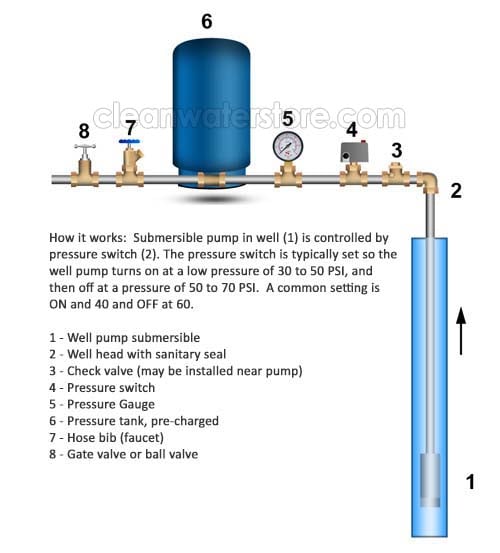How to Determine Your Well Pump Flow Rate on Wells with Pressure Tanks
An overview: The first step is to count the gallons “drawn down” from the pressure tank. This is the amount of water the pressure tank stores before your well pump needs to kick in. This is known as pressure tank ‘drawdown'.
Then the next step is to time (in seconds) how long it takes for your well pump to turn on and then turn off. This is referred to as the cut-in and cut-off cycle of the well pump.
You just need those two numbers: The amount of water in gallons, of the drawdown of the pressure tank; and the time in seconds it takes for the well pump to fill up an empty pressure tank!
Here are the Easy Steps To Take:
First, allow the well pump to build up to full pressure by running water in the home or from a hose bib or faucet until you hear the well pump kick in or pressure switch points click.
Close faucet and make sure no water is being used in the home. Well pump will build up pressure for a few minutes and then pressure switch will shut off well pump.
Next, open a hose bib (also referred to as a ‘spigot’ or ‘faucet’) anywhere near or after the pressure tank.
Run the water into a 5-gallon bucket, noting how many gallons you collect. If bucket fills up, dump out water and keep measuring and filling.
Measure the number of gallons drawn down from the pressure tank until the well pump turns on.
When you hear the pump turn on, immediately close the hose bib.
Time the period in seconds it takes for the well pump to build back up to pressure that is, between the cut- in and cut- out of the pressure switch. The pressure switch turns on the pump at a lower pressure and turns off the pump when it reaches a higher pressure.
The formula for determining the flow rate is gallons drawn down (that were measured above), divided by the seconds required for recovery, then multiplied by 60:
(Gallons / Seconds) x 60 = Gallons per Minute (GPM) flow rate..
For example, if 20 gallons are drawn down and it takes 120 seconds to build pressure back up, then: 20 divided by 120 = .166. Then multiply .166 x 60 = 10 gallons per minute flow rate.
So you have 10 GPM flow rate.
Also see: How Do Well and Pressure Systems Work?
Learn How to Troubleshoot Low Water Pressure on Well Water Systems
Click here to get code






